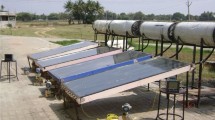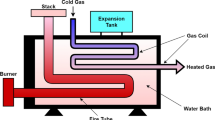Abstract
This experimental assessment aims to study the impact of twisted tape insert on city gas station (CGS) heaters performance. The interesting point in this study is that the unflavored pressure drop in many cases of using tube inserts is quite favor in this case. In other words, this insert is used in a station whose primary duty is to heat the natural gas and reduce its pressure, and the insert does a part of the pressure reduction besides enhances the heat transfer rate. The effects of twist ratio and heater water temperature on the heater performance features are assessed, and the outcomes are compared with those without inserts case. The outcomes indicated that the use of insert entails an intensification in the heater performance by up to 16% and the best heat transfer enhancement belonged to the insert with the twist ratio of 1.05 at the heater water temperature of 35 °C. In addition, the economic analysis revealed that the capital return rate and the time of the return of capital are quite desirable. Furthermore, the exergy analysis showed that the destroyed exergy diminishes by using the twisted tape insert, and the higher the twist ratio and heater water temperature, the less the destroyed exergy. This is because a CGS unit duty is reducing pressure, and using an insert can be helpful.









Similar content being viewed by others
Abbreviations
- A:
-
area, m2
- Cp:
-
specific heat KJ·(Kg °k)−1
- Dh:
-
hydraulic diameter of tube, (m)
- Eair :
-
Air exergy , (kW)
- Efuel :
-
Fuel exergy , (kW)
- Ed :
-
exergy destruction rate, (kW)
- Eexh :
-
the outlet exergy from the heater exhaust, (kW)
- ENG IN :
-
Natural gas exergy inlet, (kW)
- ENG OUT :
-
Natural gas exergy outlet, (kW)
- ech :
-
chemical exergy, (kJ)
- ep fh :
-
physical exergy , (kJ)
- f:
-
friction factor
- H:
-
convection heat transfer coefficient, W·(m2 °k)−1
- h:
-
specific enthalpy in a specific temperature, (kJ·kg2)
- ho :
-
specific enthalpy in ambient temperature, (kJ·kg2)
- k:
-
thermal conductivity, W·(m °k)−1
- L:
-
length of tube , (m)
- M:
-
molecular weight , (kg·kmol−1)
- mNG :
-
mass flow rate of the natural gas , (kg·s−1)
- m:
-
mass flow rate , (kg·s−1)
- n:
-
molar flow rate , (mol·s−1)
- Qk :
-
rate of heat transfer at the source temperature, (kJ·s−1)
- Qh :
-
heat transfer rate produced by the heater, (kW)
- p:
-
Pressure , (bar)
- po :
-
ambient pressure , (bar)
- R:
-
universal gas constant, (psi/(m3·K−1)
- S:
-
specific entropy in a specific temperature, (kJ·kg−1)
- so :
-
specific entropy in ambient temperature, (kJ·kg−1)
- T:
-
temperature (°C or °k )
- Tb :
-
the bulk water temperature, (°k)
- To :
-
ambient temperature, (°k)
- Ts :
-
surface temperature, (°k)
- Tw :
-
heater water temperature (°C)
- u:
-
mean flow velocity, (m·s−1)
- W:
-
rate of work done , (kJ)
- y:
-
twist ratio
- yt :
-
molar ratio
- Z:
-
compressibility factor
- C.G.S:
-
City Gas station
- CRR:
-
Capital Return Rate (year−1)
- LHVf :
-
low calorific value of the fuel
- Num :
-
average Nusselt number
- Re:
-
Reynolds number
- SCMH:
-
Standard Cubic Meters per Hour
- Sgen :
-
entropy produced in the system.
- TRC:
-
Time of Return of Capital, (year)
- wsh max :
-
Maximum work of chemical reaction
- ρ:
-
density, (kg·m−3)
- μ :
-
dynamic viscosity, kg·(ms)−1
- ∆E ̇_(f-t):
-
fire tube exergy balance, (kW)
- ∆E ̇_NG:
-
Natural gas exergy balance, (kW)
- ΔG:
-
Gibbs free energy, (kj)
- η:
-
Exergy efficiency
- η_th:
-
heater thermal efficiency
- ΔP:
-
pressure drop, (bar)
- ∆T_e:
-
Enhanced temperature difference (°C)
References
B. Ranjbar, E. Jafarbeigi, M. Kazemi, J. Int, Advanced Biotechnology and Research. 7, 1030–1036 (2016)
M. Farzaneh-Gord, S. Hashemi, M. Sadi, J. Energy Exploration & Exploitation. 25, 393–406 (2007)
Mageshbabu D, Kabeel A, J. Heat Transfer Research. l50, 851–863 (2019).
N. Zozulya, I.Y. Shkuratov, J. Heat Transfer-Sov Res. 6, 98–100 (1974)
A. Kumar, B. Prasad, J. Renewable energy. 19, 379–398 (2000)
P.K. Sarma, P.S. Kishore, V.D. Rao, T. Subrahmanyam, Int. J. Thermal Sciences. 44, 393–398 (2005)
Eiamsa-Ard S, Promvonge P, Int. J. Communications in Heat and Mass Transfer. 34, 176–185 (2007) .
A.R.S. Suri, A. Kumar, R. Maithani, J. Chemical Engineering and Processing. 116, 76–96 (2017)
C. Thianpong, P. Eiamsa-Ard, S. Eiamsa-Ard, J. Heat and Mass Transfer. 48, 881–892 (2012)
Ranjith, Shaji K, J. Procedia. Technol. 24, 436–443 (2016).
M. Rahimi, S.R. Shabanian, A.A. Alsairafi, J. Chemical Engineering and Processing. 48, 762–770 (2009)
A. Dewan, P. Mahanta, K.S. Raju, P.S. Kumar, J. Power and Energy. 218, 509–527 (2004)
Shabanian S, Rahimi M, Shahhosseini M, Alsairafi A, Int. J. Communications in Heat and Mass Transfer. 38, 383–390 (2011) .
A. Feizabadi, M. Khoshvaght-Aliabadi, A.B. Rahimi, Int. J. Thermal Sciences. 145, 106051 (2019)
A.M. Jacobi, R.K. Shah, J. Experimental Thermal and Fluid Science. 11, 295–309 (1995)
A. Geete, J. Exergy, Heat Transfer Research. 48, 1625–1636 (2017)
Bejan A , Advanced engineering thermodynamics. John Wiley & Sons. (2016) .
M. Farzaneh-Gord, A. Arabkoohsar, M.D. Dasht-bayaz, L. Machado, R. Koury, J. Renewable Energy. 72, 258–270 (2014)
M. Farzaneh-Gord, R. Ghezelbash, A. Arabkoohsar, L. Pilevari, L. Machado, R. Koury, J. Energy. 83, 1–13 (2015)
T.J. Kotas, The Exergy Method of Thermal Plant Analysis (Florida, Krieger Publishing Company, Malabar, 1995).
Author information
Authors and Affiliations
Corresponding author
Rights and permissions
About this article
Cite this article
Ranjbar, B., Rahimi, M. & Mohammadi, F. Exergy Analysis and Economical Study on Using Twisted Tape Inserts in CGS Gas Heaters. Int J Thermophys 42, 99 (2021). https://doi.org/10.1007/s10765-021-02848-3
Received:
Accepted:
Published:
DOI: https://doi.org/10.1007/s10765-021-02848-3




